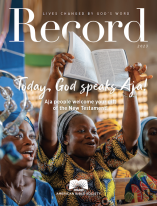10 Years of the Digital Bible Library
How the Digital Bible Library is moving us closer to a world with God’s Word in every language
If you own a smartphone, God’s Word is probably just a tap away, thanks to popular apps like the Bible App.
In the past decade, God’s Word has exploded across digital platforms, making Scripture more accessible to more people than ever before. What you might not know is that many digital Bible providers depend on one massive Scripture database to provide millions of people with God’s Word: the Digital Bible Library (DBL).
In June of 2021, the DBL celebrated its 10-year anniversary. Today, as more and more people experience God’s Word digitally, we reflect on the DBL’s past decade of ministry and look forward to a future of impact and innovation.
What Is the Digital Bible Library?
The Digital Bible Library is a single digital repository for Bible translations in thousands of languages and formats—including text, video, audio, and Braille. It’s developed and maintained by United Bible Societies, a global Fellowship of more than 150 Bible Societies in more than 240 countries and territories, operated by staff members at both American Bible Society and United Bible Societies. Together, these teams work to standardize, validate, and safeguard Bible translations while empowering ministry partners with easy access to God’s Word.
At American Bible Society, staff members Maria Ferri, John Mark Mitchell, and Bryce Allison have been faithfully working with the content managers, curators, and support experts on the United Bible Societies team—including Jared Williams, Emma Canales, Gladys Grasso, Aline Camus, and Elbert Boot—to grow the DBL from its earliest stages.
“Before the Digital Bible Library, Bible translation was a collegial activity,” remembers John Mark Mitchell, who serves as the director of Global Digital Research and Development. “Most translation organizations were working toward similar goals, but without coordinated activities or a single set of metrics.”
In practice, this meant that each organization had their own format for translations, their own process for archiving completed translations, and their own standards for licensing translations to other ministries. For Bryce Allison, executive director of the Digital Bible Lab, this lack of collaboration between translation organizations meant that getting Bibles into people’s hands was often a long and difficult journey.
“If you wanted to request a specific translation, you first had to find out who owned or managed that translation and how to contact them,” Allison says. “The next step—negotiating a license—could take months or even years. And then when you finally received the translation text, it was often in a PDF or Word document. It would take us months to convert the format so that we could use it.”
In 2011, Every Tribe Every Nation, a collaborative alliance of ministries dedicated to eliminating Bible poverty through translation, asked a question: is it possible to have organizations adopt a common standard for archiving, cataloging, and distributing translations?
“At the time, it was a big unknown,” says Mitchell. “These organizations had to set aside their format, software, and systems of choice and adopt a grander vision.”
But God was at work, and Every Tribe Every Nation alliance partners—including United Bible Societies and American Bible Society—united around the common system that became known as the DBL.
Who Uses the Digital Bible Library?
The DBL serves two types of members, or “cardholders”: contributors and consumers. Together, these members work together to serve the broader translation process.
Contributors are translation partners, including United Bible Societies and translation organizations like Tyndale and Biblica. Through the work of their translation teams, these partners generate and entrust new Bible translations to the DBL. Consumers, which include ministry partners like YouVersion, Bible Gateway, and Logos, can then easily apply for a license to use content from the DBL for Bible apps, websites, devotionals, studies, and more. Bible translators in the field also use a variety of translation resources within the DBL—including ParaText translation software, model and reference texts, and rapid review processes—to accelerate their daily work of translation.
Maria Ferri, who works as a DBL Membership, Communications and Support Lead, works closely with the United Bible Societies team to serve DBL members. “We take extreme pride in providing excellent, timely support to our DBL members,” she says. The goal, she says, is to equip members with the knowledge and resources they need to use the DBL effectively. In her role, Ferri updates DBL members with a monthly newsletter and onboards new members on the platform and processes—including licensing and permissions.
“It’s easy to forget that the Bible is a book, and that translations are intellectual property,” Ferri says. “We provide the facility for the licensing process to take place between contributing members and consuming members. Each have license agreements within the DBL, and the DBL makes the work of acquiring permissions as easy as we can possibly make it.”
Together, the United Bible Societies and American Bible Society teams work to manage content for hundreds of DBL members. When a new translation project is completed, its format is carefully checked and validated before being uploaded to the DBL. According to Ferri, content is constantly being updated and uploaded—a sure sign that the DBL is succeeding in its goal to accelerate the translation process and make it easier for ministries to share the translations and formats of Scripture their audiences need.
“We definitely provide a fast track to getting God’s Word into people’s hands,” says Ferri. She points to YouVersion as a prime example—with more than 500 million downloads, the Bible App has made God’s Word accessible in nearly 1,800 languages. According to YouVersion, 95 percent of those languages originated from the DBL.
“YouVersion has been a great ministry impact and tech partner,” says Mitchell. “We celebrate every milestone they hit because we’re one of the primary sources of content for the YouVersion app. We’ve walked alongside each other throughout the past ten years.”
What’s Next?
Over the past decade, it’s clear how far the DBL has come. Many of the significant technical hurdles that the United Bible Societies and American Bible Society teams faced have been reduced or eliminated. Today, the DBL is a busy and active system, and while there are always new opportunities for growth as technology advances and Bible delivery and engagement needs evolve, its mission remains clear.
“It’s all about making the Bible accessible,” says Allison. “Over the past decade, there’s been a tremendous effort in getting so many Bibles compiled, formatted, and archived in a centralized location. Now, we begin to focus even more on how to make the DBL’s content more accessible—so that apps, websites, and ministry partners have a clear, easy path to publishing God’s Word and reaching more people.”
The end to that path might be closer than many realize. “Over the past 10 years, not just the DBL but the overall pace of translation has drastically increased,” Allison says. “Now, we have realistic end goals in sight: a Bible in every language!”
What’s it like being part of this mission?
“It’s an honor. And it’s exciting!” Ferri says. “We’re reaching people who wouldn’t have otherwise been reached in a faster way, and we’re saving lives. I thank God every day for the privilege of helping people receive God’s Word – digitally!”
***
Each new upload to the DBL moves us one step closer to a world where every person can experience the truths of the Bible in their heart language. As God’s Word continues to go forth and transform hearts and lives, we remain confident in God’s promise to accomplish his purposes through Scripture:
“My word is like the snow and the rain
that come down from the sky to water the earth.
They make the crops grow
and provide seed for planting and food to eat.
So also will be the word that I speak—
it will not fail to do what I plan for it;
it will do everything I send it to do.”Isaiah 55:10-11 GNT

Elisabeth Trefsgar
Elisabeth Trefsgar is a content specialist for American Bible Society. She has made a home in New Jersey and Sofia, Bulgaria, and is always on the lookout for the next adventure. She is passionate about seeing communities around the world flourish through the power of God's Word and the efforts of the local church. When she isn't writing, you can find her reading good stories, photographing local sights, and spending time with friends.
Thanks to the support of our faithful financial partners, American Bible Society has been engaging people with the life-changing message of God’s Word for more than 200 years.
Help us share God's Word where needed most.
Sign up to stay in touch with how God is changing lives with his Word!









